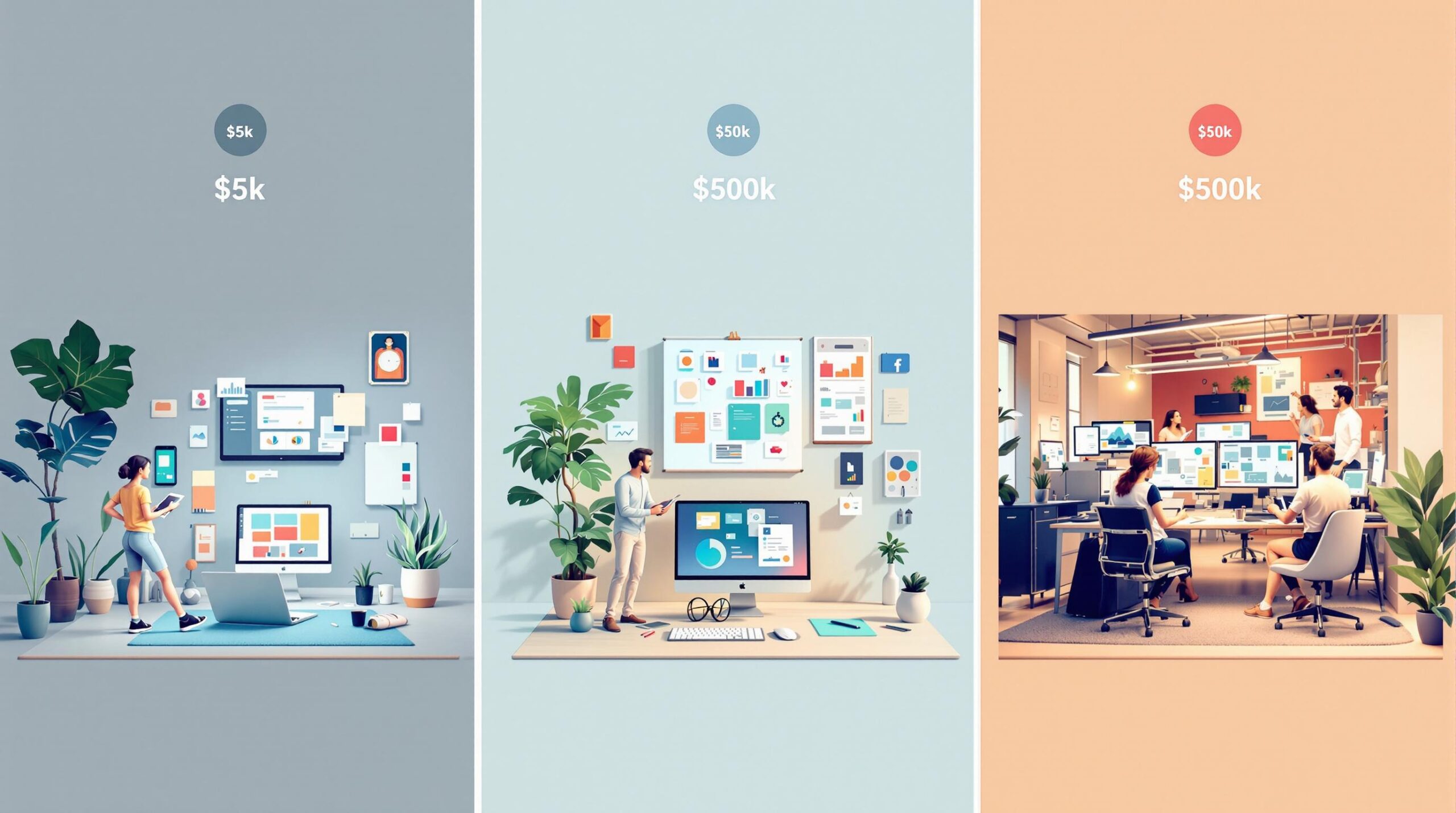
When it comes to mobile app design, your budget determines what you can achieve. Here’s a quick breakdown:
- $5k Budget: Covers basic app design with simple features, 5-10 screens, and limited customization. Ideal for testing ideas or creating a prototype.
- $50k Budget: Offers polished, user-focused designs with advanced features like animations, branding, and responsive layouts. Suitable for feature-rich apps.
- $500k Budget: Enables enterprise-level apps with cutting-edge designs, AI, AR/VR, and robust scalability. Perfect for large-scale or complex projects.
Quick Comparison
| Budget Level | Features | Team Expertise | Deliverables | Advanced Features |
|---|---|---|---|---|
| $5k | Basic UI/UX, 5-10 screens | Junior designers, freelancers | Wireframes, simple prototypes | None |
| $50k | Polished design, 15-20 screens | Senior designers, project managers | Full UI kit, interactive prototypes | Custom animations, basic integrations |
| $500k | Advanced visuals, 3D, AR/VR | Expert teams, UX researchers | Enterprise-grade design systems | AI, enterprise security, immersive features |
Your budget impacts design complexity, team expertise, and scalability. Choose based on your goals and long-term needs.
How Much Does It Cost to Design an App?
1. What You Get with a $5k Budget
A $5k budget is considered an entry point for mobile app design. Here’s a breakdown of what you can typically expect from this level of investment.
Design Complexity
With $5k, you can expect a straightforward UI/UX design for 5-10 screens. Designers will stick to standard fonts, template-based layouts, and simple color schemes. The focus here is on functionality rather than visual appeal [6].
Team Expertise
At this budget level, you’ll likely work with junior designers or freelance professionals, often based offshore. Their experience with complex projects may be limited. You’ll usually get 1-2 rounds of revisions, basic project management, and a timeline of 2-4 weeks [1].
Deliverables
Here’s what’s typically included:
- Basic wireframes and user flows
- A clickable prototype
- A few screen designs with essential visual elements
- A simple style guide
Advanced Features
Custom animations or third-party integrations are out of reach with this budget. The focus will remain on delivering the app’s core functionality [2][4].
Tools and Technology
To keep costs low, designers rely on free or open-source tools. This means you won’t have access to premium design resources or advanced prototyping options [6].
A $5k budget works well for testing ideas, building prototypes, or designing simple utility apps. However, if you aim to include more advanced features or refine the design further, you’ll need to plan for a larger investment.
2. What You Get with a $50k Budget
A $50k budget moves beyond basic prototypes, allowing for well-designed, user-centered apps with advanced features and a professional touch.
Design Complexity
With this budget, you can expect polished, visually appealing designs that include branding. Typically, it covers 15-20 screens with detailed user flows and interactions. These designs are tailored to connect with your target audience effectively [1].
Team Expertise
At this price point, your project will benefit from a skilled team, which usually includes:
- Senior UI/UX designer for high-quality design work
- Dedicated project manager to keep things on track
- Quality assurance specialists to ensure perfection
- Animation experts for smooth, engaging visuals
The project timeline generally spans 8-12 weeks, allowing for detailed revisions and improvements [3].
Deliverables
| Component | Details |
|---|---|
| Design Assets | Full UI kit, custom icons, and illustrations |
| Documentation | Comprehensive design system with a style guide |
| Prototypes | High-fidelity interactive prototypes |
| User Research | Basic testing and feedback integration |
| Technical Specs | Developer-ready specifications |
Advanced Features
A $50k budget opens the door to more advanced design features, such as:
- Custom animations and micro-interactions for better engagement
- Integration with third-party tools
- Complex user flows and tailored experiences
- Responsive designs for multiple devices
- Basic gesture controls like swipe or pinch-to-zoom
"A smaller budget gets you a basic working product – a so-called MVP (minimum viable product). But this MVP won’t have the polish or flexibility needed to truly compete in today’s market." – Clockwise Software Blog [5]
This budget level is perfect for businesses aiming to balance quality and cost. While it provides a significant step up from a $5k budget, some advanced features may still require additional investment [2].
A $50k budget sets a strong foundation for a competitive app, but scaling to a $500k budget takes things to an entirely different level.
sbb-itb-7af2948
3. What You Get with a $500k Budget
A $500k budget takes app design to the enterprise level, allowing for sophisticated applications that incorporate advanced technologies and deliver exceptional user experiences. This level of investment goes far beyond what lower budgets can achieve.
Design Complexity
With this budget, you can expect:
- Fully tailored interfaces featuring advanced visuals like 3D graphics, animations, and micro-interactions.
- Comprehensive design systems that work seamlessly across multiple platforms.
- Custom-branded assets, including bespoke illustrations.
- Gesture-based navigation for a more intuitive user experience.
Team Expertise
A high-level budget like this means working with an expert team. Here’s what that team typically includes:
| Role | Focus |
|---|---|
| Design Director | Guides strategic vision and ensures brand consistency. |
| Senior UX Research Team | Conducts in-depth user research and testing. |
| Specialized Design Teams | Focused on UI/UX, motion, and interaction design. |
| Technical Architects | Develops system architecture and handles integration. |
Deliverables
At this level, you’ll receive:
- Detailed research and testing documentation, including user studies, market analysis, and testing results.
- An enterprise-grade design system with a robust library of components.
- High-fidelity prototypes that cover multiple user scenarios.
- Comprehensive technical specifications to guide development teams.
Advanced Features
Applications developed with this budget can include:
- AI-driven personalization and learning features.
- Immersive AR/VR elements for an engaging user experience.
- Enterprise-level security measures to protect sensitive data.
"Cross-platform development ensures consistent experiences and lowers maintenance costs." [2]
This level of investment leaves no room for compromise. It allows for rigorous testing and refinement, minimizing post-launch issues. Ideal for enterprise solutions or consumer apps aiming for large-scale adoption, it positions your product to compete directly with industry leaders.
Now that we’ve covered each budget tier, let’s dive into a comparison to see which option aligns best with your goals.
Comparing the Pros and Cons of Each Budget
Here’s a quick look at the advantages and drawbacks of different budget levels to help you decide what works best for your project.
| Budget Level | Advantages | Limitations |
|---|---|---|
| $5k | Quick delivery, low upfront cost, basic feature testing | Entry-level designers, limited customization, potential for redesign costs |
| $50k | Professional design, custom UI, good feature set | Limited advanced features, basic animations, moderate scalability |
| $500k | High-end scalable solutions, expert teams, advanced features | Higher post-launch costs and complexity, longer timelines |
Your choice will depend on your business goals and long-term plans. For instance, while a $5k budget gets you started with minimal investment, businesses often end up spending an extra $10,000 to $50,000 later on modifications when beginning with a basic setup [2].
A $50k budget is often a middle ground, offering a balance of cost and quality. It’s ideal for building professional apps, such as e-commerce platforms or utility-focused applications, while keeping ongoing expenses reasonable [1].
On the other hand, a $500k budget is suited for enterprise-level projects that require advanced features like AI-driven personalization or AR/VR capabilities. It also allows for rigorous testing and long-term scalability, making it a smart choice for organizations with complex needs [1].
Key points to keep in mind:
- Larger budgets typically lead to longer development timelines but provide more scalable and maintainable solutions.
- The complexity of the user experience you aim to deliver will directly influence your budget.
- Don’t forget to factor in future updates and maintenance when calculating overall costs.
Choosing the right budget is all about finding the right balance between your app’s goals, available resources, and the quality you aim to achieve.
Conclusion
When it comes to mobile app design budgets, each price point offers different outcomes and opportunities. Whether you’re working with $5k, $50k, or $500k, your budget will directly influence not only the app’s initial features but also its long-term growth potential and market impact.
A $5k budget is ideal for creating basic apps with limited customization. This is perfect for MVPs or simple utility apps where functionality is more important than polished design. While this option is affordable, it’s best suited for testing ideas rather than building a fully scalable product.
The $50k range strikes a balance for many businesses. It allows for professional design, custom UI elements, and modern features without breaking the bank. This budget typically supports app development costs between $50,000 and $120,000 [4], making it a good choice for feature-rich apps with user-friendly interfaces.
For enterprise-level projects, a $500k budget opens the door to advanced features and robust development approaches. This level of investment supports:
- Cross-platform development and scalable frameworks
- In-depth user testing and quality assurance
- High-end design, including animations and custom branding
This tier is best for businesses aiming for large-scale adoption or industry leadership.
When deciding on your budget, keep these factors in mind:
- Scalability and maintenance: Plan for ongoing costs and platform updates.
- Market expectations: Understand your users’ needs and how your app fits into the competitive landscape.
- Core features: Focus on delivering value through essential features first.
Ultimately, your app’s success hinges on aligning your budget with your goals and your users’ needs. Whether you’re launching a simple MVP or a fully-featured platform, make sure your investment supports both immediate priorities and future growth.
FAQs
How much should I charge for an app design?
The cost of app design depends on factors like location, expertise, and the project’s size and complexity. Here’s a breakdown to help you understand pricing:
App design costs can range widely. A basic UI design might cost between $2,000 and $10,000, while more complex, custom designs with advanced features could go beyond $50,000 [2][4]. If you’re designing for iOS, Android, or cross-platform apps, the total cost can land anywhere from $20,000 to $500,000, depending on the scope [2].
Here are some key factors that influence pricing:
- Project Complexity and Platform: Features, functionality, and the platform (iOS, Android, or both) play a big role. Adding custom UI elements, animations, or advanced features will push costs higher [2][4].
- Expertise Level: Rates vary by experience. Designers handling MVPs might charge $25-$40/hour, while those working on advanced, feature-rich apps often charge $150/hour or more [4].
When setting your pricing, aim to stay flexible. This allows you to adjust based on the unique needs of each client and the complexity of their project. A flexible approach helps you remain competitive while tailoring your services to fit specific requirements.

